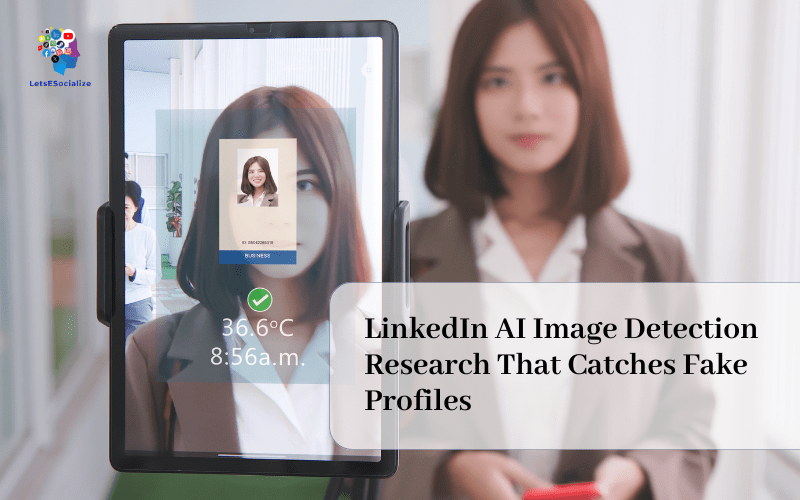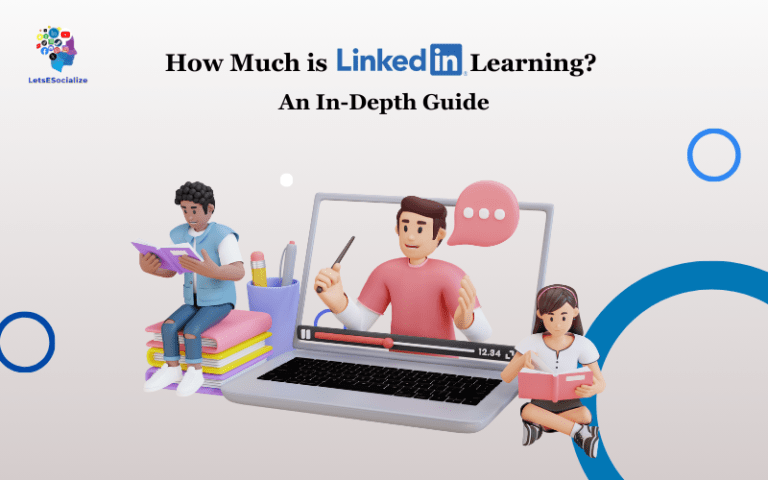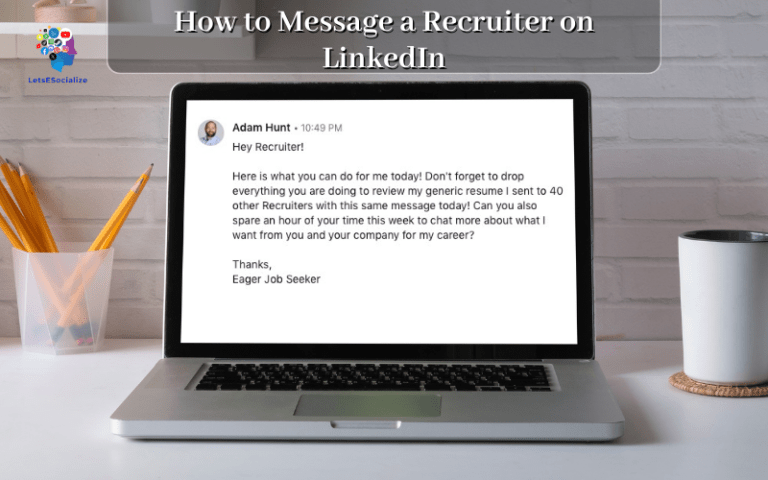LinkedIn, the social network for professionals, has revealed new artificial intelligence (AI) research that uses image detection to catch fake profiles. This new technique analyzes profile photos and looks for signs that they are not genuine pictures of real people.
The goal is to curb the spread of misinformation and fraudulent activity on the platform. Having accurate profile information builds trust between members. Let’s take a look at how LinkedIn’s AI image detection works and what it means for the future of social media.
Table of Contents
Overview of LinkedIn AI Image Detection Research
LinkedIn researchers have created an AI system that examines profile photos uploaded to the site. It looks for subtle signs that indicate the photo is not of a real person. Some things it analyzes:
- Inconsistencies around the head/neck area
- Unnatural skin textures or tones
- Mismatching facial features or blurring
- Reuse of the same image in multiple profiles
The AI has been trained on LinkedIn’s existing dataset of profile photos. This helps it identify patterns that differentiate real photos of people from fakes.
Also read: 7 Latest LinkedIn Updates Coming In 2023
Implications for Fake Profiles and Misinformation
Catching fake profiles is important for limiting the spread of misinformation on social networks. Profiles using AI-generated or stolen photos can share false information while posing as real people.
LinkedIn’s research has broader implications as other social networks also grapple with fake accounts used to propagate harmful content. The technique of using AI to analyze profile images could be adopted by other platforms like Facebook, Twitter, Instagram, etc.
It demonstrates that AI has progressed enough to detect such fakes. But it also represents an escalating AI arms race, as methods for generating convincing fake images will continue advancing too.
How LinkedIn AI Image Detection System Works
LinkedIn has not revealed the full technical details behind its AI fake profile photodetection system. But here is what we know about how it functions:
1. Analyzing Pixel Patterns
The AI system breaks down profile photos into pixel patterns. It looks for inconsistencies in gradients, textures, and boundaries between different elements in the image. Things like unnatural skin texture or irregular face/hair boundaries can indicate a fake.
2. Checking Facial Features and Shapes
The locations, proportions, and relationships between key facial features like eyes, nose, mouth, etc. provide signals about authenticity. A mismatch in expected eye shape or positioning for a given face shape may be a red flag.
3. Comparing Multiple Photos of a Person
The AI analyzes collections of photos associated with a single profile. It looks for unnatural inconsistencies across multiple images that should depict the same person. This can reveal AI-generated or borrowed profile pics.
4. Evaluating Against Benchmark Datasets
By comparing photos against benchmark datasets of real human faces, the AI can check for statistical anomalies. Images that fall too far outside the expected parameters get flagged for further review.
5. Training on LinkedIn’s Existing Photos
The deep learning models that power the analysis are trained on LinkedIn’s own corpus of member profile photos. This helps tune detection accuracy for fakes vs real pics specific to their platform.
Challenges and Limitations of AI Fake Profile Detection
While LinkedIn’s research shows promising results, AI-based fake profile identification has some challenges and limitations:
- Adapting to new techniques: As methods for generating fake faces advance, the AI must continually update to recognize new patterns. A constant arms race between detection and creation.
- Resource requirements: Processing high volumes of images requires ample training data plus GPU/TPU clusters for acceptable speed and throughput.
- Maintaining accuracy: Even with robust training, no system is perfect. There is always a tradeoff between false positives and false negatives.
- Subjective judgments: What constitutes a “fake” photo involves nuanced human judgment. Setting thresholds for AI decision making around edge cases is difficult.
- Addressing biases: Like any AI system, biases in training data can lead to uneven accuracy across demographic groups.
LinkedIn will likely need to combine its AI tool with human expertise to make final determinations on disputed profiles. Getting the right balance is key for its long-term success.
Also read: The Ultimate Guide on How to Endorse Someone on LinkedIn in 2023
LinkedIn AI Plans and Roadmap
The image detection capability is just one aspect of LinkedIn’s broader initiative to apply AI across its platform. Some other areas they are exploring with AI include:
- Predictive analytics for better targeting content to members
- Automated translation to expand reach across languages
- Matching job seekers to open positions by skills/interests
- Chatbots to assist with common user questions/requests
- Recommendation engines for social connections, jobs, content, etc.
The volume of data LinkedIn has makes it well-suited to developing robust AI models. As one of the world’s largest professional networks, they have over 810 million members and keep growing.
While AI fake profile detection is an important security application, LinkedIn is investing heavily in AI for improving user experience and engagement too. They aim to leverage AI to enhance professional networking and opportunities in new ways.
Impacts on Social Media and the Online World
LinkedIn’s AI-powered fake profile identification capability underscores how AI is rapidly transforming many aspects of social media and the digital world. A few key impacts this trend highlights include:
- Decreased spread of misinformation: Catching fake profiles aids the fight against misinformation proliferating online. But it doesn’t stop the sources from creating such fakes.
- Heightened pressure for online authenticity: As AI verification spreads, there will be greater demands for authentic digital identities, photos, videos, content, etc. from real sources.
- Rise of specialized synthetic media detection: More platforms will need dedicated capabilities like LinkedIn’s to combat fakes. But generative AI will also grow more sophisticated.
- Arms race between fraudsters and detectors: An ongoing battle is emerging between those generating AI fakes and those developing tech like LinkedIn’s to catch them. Who stays ahead remains to be seen.
- Tougher terrain for trolls and bots: Bad actors thriving on social networks via fake accounts will find their methods challenged by AI systems like LinkedIn’s identifying their tricks.
- Benefits beyond social networks: While LinkedIn’s tech focuses on profiles, similar AI could help combat fakes used for many online frauds – phishing, scams, identity theft, and more.
Also read: How to Create a LinkedIn Account: The Ultimate Guide for Beginners and Experts
Overall, AI has become both a necessary tool and a peril as the ubiquity of advanced synthetic media grows. Responsible development and use of such capabilities will be critical going forward.
Evaluating Ethical Considerations
As with any AI capability, there are ethical factors to weigh regarding fake profile detection systems like LinkedIn’s. A few concerns that warrant consideration include:
- Could such systems wrongly accuse real users who look “fake” to the AI?
- What recourse do users have to contest a ruling of being fake/fraudulent?
- Does the tech exhibit biases against certain demographic groups?
- Is it prone to circumvention by new generations of fakes?
- How will innocent users caught in the crossfire feel about this level of automated surveillance?
- Does the urgency to combat fraud justify this approach despite downsides?
There are rarely easy answers with AI ethics. But through research studies, user testing, transparency, and open communication, companies like LinkedIn can hopefully address concerns responsibly. Ongoing scrutiny of all AI systems remains important.
Outlook for the Future
LinkedIn’s research hints at a future where AI fake detection becomes standard across social networks and apps. But major questions surround how this plays out:
- Will fakes multiply faster than AI can catch them? Or will detection gain the upper hand?
- How far should these capabilities reach into less clearly unethical fakes?
- Will the detection arms races ultimately fragment online identities and networks?
- Could fakes need to someday declare themselves to avoid deception bans?
- Will stronger fake detection build greater trust in online interactions? Or erosion from continual doubt?
Given the central role social media plays in modern life, these issues will impact society and culture in 2023. But with careful, democratic technology governance, we can hopefully steer toward empowering outcomes.
Also read: What Are The Benefits Of LinkedIn?
Conclusion
LinkedIn AI fake profile photo detection represents cutting edge progress on an important problem – limiting fraud to build trust online. But it also touches only the surface of much deeper challenges that advanced synthetic media raise for our digital future.
Through thoughtful innovation, ethical codes, and open discussion, hopefully, technology leaders can find the right path in this complex domain. With so much still unknown, the road ahead promises to be filled with both amazing possibilities and unforeseen risks.
Frequently Asked Questions
-
What are the key benefits of LinkedIn AI fake profile detection?
The main benefits are reducing misinformation spread via fake profiles, fighting online fraud, and overall working to build more trust on the platform by cracking down on fakes.
-
What are some current limitations of this technology?
Limitations include staying ahead of new types of fake generation methods, biases in training data, balancing false positives vs negatives, and subjectively judging what constitutes a fake profile photo.
-
How exactly does the AI system analyze profile photos to determine fakes?
It looks for inconsistencies in pixel patterns, facial features/shapes, collections of photos, and comparisons against real photo datasets. LinkedIn has not provided full technical details publicly.
-
Will this technology completely eliminate fake profiles and misinformation?
Unfortunately no. As AI detection improves, AI generation of fakes will also evolve. It will be an ongoing battle, but better detection will help reduce fakes’ impact.
-
Could this technology wrongly accuse real people’s profiles of being fake?
Yes, that is a risk if thresholds are not calibrated carefully to minimize false positives. LinkedIn will likely need robust appeals processes for users to contest fake determinations.
-
Will other social networks adopt similar AI fake detection systems?
Very likely yes, since all major platforms struggle with the issue of fake profiles used for spreading misinformation, scams, and other harmful activities. The techniques will spread but so will generation of more sophisticated fakes.
-
What ethical concerns should be considered around AI-based fake profile detection?
Concerns include proper accountability, avoiding demographic biases, ensuring due process for accused users, proportionality of detection methods, and gently balancing security versus privacy/freedom.
-
What does this development say about the future of AI on social media?
It indicates AI will be increasingly central for both positive improvements and combatting risks. Responsible governance of such AI systems will be crucial as they impact social media experiences and business models.







